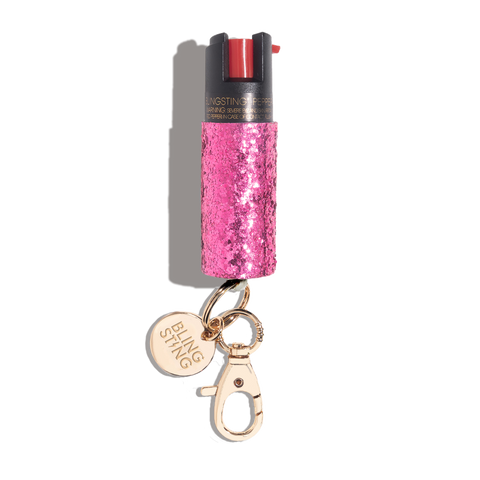Does Pepper Spray Cause Permanent Damage? Understanding the Long-Term Risks
Does pepper spray cause permanent damage? Our article breaks down the risks of long-term effects on your eyes, breathing, and skin after exposure to pepper spray, providing you with the answers you need straight away..
Table of Contents
- Key Takeaways
- The Reality of Pepper Spray's Effects
- Long-Term Consequences of Pepper Spray Exposure
- Factors Influencing Severity of Pepper Spray Effects
- Preventing and Mitigating Pepper Spray Effects on Accidental Contact
- Urgent Response and Decontamination
- Seeking Advanced Medical Care
- Exploring the Legal Ramifications and Incidents in Police Custody
- Resisting Arrest and the Application of Force
- Conducted Energy Weapons versus Pepper Spray
- Summary
- Frequently Asked Questions
Key Takeaways
- Pepper spray’s primary ingredient, capsaicin, can cause temporary effects such as burning, difficulty breathing, and temporary blindness, but can also lead to severe injuries like corneal abrasions and respiratory issues.
- Long-term exposure to pepper spray can cause serious health problems like chronic breathing issues, permanent eye damage, and even psychological trauma, and the risks are higher for those with pre-existing conditions.
- The best way to prevent and reduce pepper spray damage is to decontaminate immediately and seek medical attention. Laws on the use of pepper spray vary from state to state and can be influenced by police racial biases.
The Reality of Pepper Spray's Effects
Pepper spray causes intense burning sensations, temporary blindness and shortness of breath. Symptoms include: red, watery eyes, cough, nasal irritation, skin rashes, blisters, and burns.
While most effects are temporary, serious injuries such as corneal abrasion, wheezing and skin blisters can happen.
The severity of these effects is largely determined by the active ingredient in pepper spray - capsaicin, found in chili peppers. This brings us to our first deep dive: the role of capsaicin in pepper spray’s effects.
Chili Peppers and Capsaicin

Capsaicin, the main irritant from edible pepper plants like jalapeños, is the active ingredient in pepper spray. The particular variant used in pepper sprays is known as oleoresin capsicum (OC), which is produced by extracting capsaicin from finely ground capsicum peppers using an organic solvent like ethanol.
The severity of the reaction caused by the concentration of capsaicin in the OC varies, with higher levels resulting in more intense effects.
Some typical effects of being exposed to pepper spray include:
- Feeling a burning sensation on the skin
- Experiencing redness and inflammation
- Having excessive tearing and mucus production
- Facing difficulty in breathing
- Temporary blindness
It's worth mentioning that the impact of pepper spray can differ based on an individual's sensitivity and the level of exposure. If you happen to come into contact with pepper spray, it's advisable to wash the affected area with cold water and seek medical help if needed.
The strength of pepper spray is determined by capsaicin, but its usage extends far beyond personal safety, being utilized by law enforcement agencies worldwide.
Usage for Law Enforcement and for Self-Defense
Pepper spray, also referred to as bear spray when employed against aggressive animals, is widely used by law enforcement for managing crowds and by individuals as a means of personal protection against various threats, including aggressive humans and animal attacks.
Its versatility is enhanced by the fact that it is available in different formats, ranging from small handheld containers for targeting specific individuals to larger canisters for dispersing in larger areas.
However, when used for crowd control, pepper spray can unintentionally affect multiple individuals, leading to a wider range of effects and raising concerns about its use in such situations.
This brings us to the lesser-known aspect of pepper spray - its potential long-term consequences, which may include
- respiratory problems,
- eye damage,
- skin irritation and burns,
- allergic reactions,
- and even psychological trauma
With all these possible effects, it is important to use your pepper spray responsibly and only for self-defense. It also helps to practice the use of pepper spray which is why we have a water-filled spray to practice using an actual pepper spray.

Our water-filled practice canister
Long-Term Consequences of Pepper Spray Exposure
While the immediate effects of pepper spray are widely recognized, the potential long-term consequences are less known. Prolonged exposure to pepper spray can lead to more significant and potentially lasting health issues, such as:
- Respiratory problems
- Eye damage
- Skin irritation and burns
- Allergic reactions
- Psychological trauma
It is important to use pepper spray responsibly and only in self-defense situations.
The severity of these health issues can range from skin and eye damage to respiratory complications. Let’s delve deeper into these potential long-term consequences.
Skin and Eye Damage
Capsaicin in pepper spray can cause corneal abrasions - scratches on the eye’s cornea, potentially leading to long-term vision issues if severe and not adequately addressed. A single exposure to pepper spray is typically harmless to the eyes, but repeated exposure can lead to lasting changes in corneal sensitivity.
About 10% of pepper spray incidents result in corneal abrasions, often exacerbated by the afflicted individuals rubbing their eyes. Severe skin exposure to pepper spray may lead to skin blisters, which pose a risk of long-term or permanent skin damage if not properly treated.
Respiratory Issues
Apart from the skin and eyes, pepper spray can also affect the respiratory system. Inhaling pepper spray can exacerbate respiratory conditions such as asthma or COPD, increasing the risk of long-term respiratory complications for individuals with these pre-existing conditions.
Rare fatal outcomes related to pepper spray exposure have been reported, especially in individuals with preexisting conditions such as asthma. A study on the long-term effects of tear gas exposure showed that even after several months of cessation of exposure, individuals could experience pulmonary function deterioration and persistent respiratory complaints.
Factors Influencing Severity of Pepper Spray Effects
The severity of pepper spray effects can vary depending on several factors, including:
- Whether it is delivered as an aerosol or in a liquid stream
- The number of individuals affected
- The setting of exposure, such as being in a confined indoor space versus an open outdoor space.
Environmental conditions, including wind and humidity, can impact the dispersal and concentration of pepper spray, which in turn affects the intensity of its effects. Let’s delve deeper into two significant factors: the amount and duration of exposure, and individual health conditions.
Amount and Duration of Exposure
Typical effects of pepper spray range from 20 to 90 minutes, with prolonged eye irritation lasting up to 24 hours. However, repeated exposures can cause tachyphylaxis, leading to reduced sensitivity to capsaicinoids over time.
It is rather rare for pepper spray to have long term effects, although according to a study frequent exposure to pepper spray can result in long-term effects in 1 out of 15 individuals particularly ocular, respiratory (such as chronic bronchitis), and dermal. This thus applies to those law enforcement in training and not with respect to public use for self defense. Exposure in closed environments significantly exacerbates the negative impact on respiratory health which again applies to police and law enforcement training.

Coast Guard Training for Pepper Spray Use
Effect on Those with Preexisting Health Conditions
A person’s preexisting health issues can likewise impact the effects of pepper spray. People with respiratory issues, for example, asthma or COPD might encounter more serious breathing complications from pepper spray, representing a higher risk for serious breathing impacts entanglements.
Additionally, those wearing contact lenses can experience eye irritation when exposed to pepper spray, which can potentially result in extreme discomfort due to the very sensitive eye surface. People with skin conditions like dermatitis or psoriasis might experience the ill effects of increased skin sensitivity to pepper spray, prompting more extreme irritation..
Certain drugs, such as beta-blockers, can worsen the cardiovascular effects of pepper spray, for example, raising blood pressure and heart rate.
Preventing and Mitigating Pepper Spray Effects on Accidental Contact
Washing the entire body quickly with a generous amount of soap and water can help minimize the risk of long-term damage.
If you've been exposed to pepper spray, it's important to act fast to lessen the effects. Rinse the affected skin immediately with water. If water isn't available, you can use a cloth or paper towel dampened with vegetable oil to carefully wipe away the irritants.
Other treatments may include
- flushing the eyes with room-temperature water,
- nasal irrigation with a saline solution,
- steam treatments for respiratory issues.
Remember to be gentle during decontamination and avoid getting the irritants on uncontaminated clothing.
Urgent Response and Decontamination
Taking immediate action after exposure can greatly reduce the severity of the effects. It is recommended by Poison Control to quickly move to an area with fresh air and begin decontamination procedures.
This involves flushing the eyes with saline solution or water, making sure to direct the flow away from the nose.

Washing eyes after accidental eye spray
After irrigating the eyes for at least 15 minutes, it is advised to wash the head using diluted dish-washing detergent or soap. Be careful to avoid any further contamination of the eyes. To alleviate symptoms on the eyes, try blinking rapidly and remove and wash any eyeglasses.
For skin symptoms, thoroughly wash the affected areas. If you have been exposed to pepper spray, it is important to remove any clothing or jewelry that may have come into contact with it. Use rubber gloves or tools to avoid touching the spray with bare skin. Dispose of all contaminated items in sealed plastic bags according to the guidelines provided by your local health department.
Seeking Advanced Medical Care
If you are experiencing prolonged or severe symptoms after being exposed to pepper spray, it is crucial to seek medical attention. If the pain persists for more than 45 minutes, it is recommended to seek advanced medical care. In case of respiratory distress, such as difficulty breathing or chest pain, call emergency services immediately.
Medical providers may not fully understand the long-term effects of pepper spray exposure, especially severe damage to the cornea and conjunctiva. Therefore, it is important to seek professional care for conditions like reduced corneal sensibility and potential stromal scarring.
Those providing first aid should closely monitor the victim's breathing and be prepared to administer necessary interventions, such as inhalers, oxygen, or epinephrine, if severe respiratory issues arise. Providing reassurance to the patient is also essential in managing pain and panic caused by pepper spray exposure.
Exploring the Legal Ramifications and Incidents in Police Custody
When it comes to the legal side of things, the consequences and occurrences in police custody involving pepper spray can differ depending on the jurisdiction. Some states have strict regulations on its use and possession.
For instance, in California, misusing pepper spray can lead to a hefty fine, imprisonment, or even a felony charge. Similarly, states like Michigan, New York, and North Carolina have their own specific rules and regulations.
A recent study conducted by Harvard University in 2016 shed light on the disproportionate use of pepper spray by law enforcement against Black individuals, indicating potential systemic racial biases within the police force.
Resisting Arrest and the Application of Force
Pepper spray is viewed as a tool for specific situations in law enforcement and may not always be the most suitable response, especially in rapidly escalating situations. In cases where a suspect is armed or attempting to reach for a weapon, police officers may resort to using higher levels of force beyond pepper spray to swiftly address the danger. But what about other options besides pepper spray, such as conducted energy weapons (CEWs) like Tasers?
Conducted Energy Weapons versus Pepper Spray
CEWs like Tasers offer an alternative to pepper spray. However, their usage also comes with risks, particularly for individuals who are more vulnerable. Underlying medical conditions or the use of illegal substances can significantly increase the dangers associated with Taser deployment.
In 2018, at least 49 individuals in the US lost their lives after being shocked by police with a Taser, with some cases involving the use of force leading to positional asphyxiation.
Prolonged or repeated exposure to a Taser raises the likelihood of severe injury or death, including sudden cardiac arrest. Certain groups, especially those who are more vulnerable, face heightened risks with CEWs, as they can potentially result in fatalities, especially when combined with drug use or heart conditions.
Nevertheless, the likelihood of sustaining injuries from exposure to CEWs, particularly in stun mode, is considered to be minimal, as research indicates. Stun guns are still a good self-defense tool and can actually save your life particularly in an imminent attack by an assailant.
Summary
In conclusion, pepper spray is an effective tool for protection even life-saving, and it is always a wise practice to carry one in the face of danger. It does come with potential risks and consequences and should hence be used only for self-defense. The immediate effects can be debilitating, and long-term exposure can lead to severe health issues.
The severity of these effects depends on factors like the concentration of capsaicin, duration of exposure, environmental conditions, and individual health. While immediate response and decontamination can help, seeking medical attention is crucial for prolonged or severe symptoms.
Practice of use for self-defense will definitely help which is why Blingsting has a water-filled practice canister available to give you more confidence in the unfortunate circumstance that an emergency necessitates actual use of pepper spray vs an attacker or an aggressive animal.
Frequently Asked Questions
1. How long does it take to recover from pepper spray?
Recovering from pepper spray usually takes around 30 minutes, although some individuals may experience longer-lasting effects.
2. What are the psychological effects of pepper spray?
Pepper spray can cause psychological effects such as fear, panic, and cognitive disorientation, in addition to its physical effects. It can be especially distressing for individuals with a phobia of spicy foods or sensitivity to capsaicin.
3. What can neutralize pepper spray?
To neutralize pepper spray, mix liquid antacid like "milk of magnesia" or Maalox with water in a 50/50 ratio. Avoid using antacid with mint flavoring.
4. Can a stun gun be lethal?
Yes, a stun gun can be lethal if it disrupts heart function, potentially leading to cardiac arrest and even death. It's important to use stun guns responsibly and be aware of the risks involved.
5. What is the active ingredient in pepper spray?
The active ingredient in pepper spray is capsaicin, which is produced from chili peppers in the form of oleoresin capsicum (OC).




